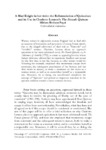Mostrar o rexistro simple do ítem
A Mad Knight in her Attic: the Reformulation of Quixotism and its Use in Charlotte Lennox’s The Female Quixote
| dc.contributor.author | Borham Puyal, Miriam | |
| dc.date.accessioned | 2016-07-15T08:35:22Z | |
| dc.date.available | 2016-07-15T08:35:22Z | |
| dc.date.issued | 2008 | |
| dc.identifier.citation | AEDEAN 2008, 31: 143-149 ISBN-978-84-9749-278-2 | |
| dc.identifier.isbn | 978-84-9749-278-2 | |
| dc.identifier.uri | http://hdl.handle.net/2183/17028 | |
| dc.description.abstract | [Abstract] Women writers in eighteenth century England had to deal with accusations of immorality and perversion of young female minds, due to the alleged subversion of their role as “domestic” and “invisible” women. Charlotte Lennox chose to approach quixotism in her most celebrated novel, The Female Quixote, or, the Adventures of Arabella (1752), to create an appealing heroine whose literary delusions allowed her to experience freedom and power for the first time in her life. Lennox, as other writers would do following her example, employed that momentary escape from constraint, the subsequent punishment of her heroine and her final return to reason, to make a statement on her status as a woman writer, as well as to consolidate herself as a respectable one. Moreover, by so doing, she transformed completely the concept of “Quixote” and proved an important transition in the quixotic tradition towards a more romantic heroine. | |
| dc.language.iso | eng | |
| dc.publisher | Universidade da Coruña | |
| dc.title | A Mad Knight in her Attic: the Reformulation of Quixotism and its Use in Charlotte Lennox’s The Female Quixote | |
| dc.type | info:eu-repo/semantics/conferenceObject | |
| dc.rights.access | info:eu-repo/semantics/openAccess |






